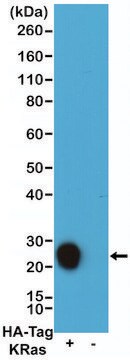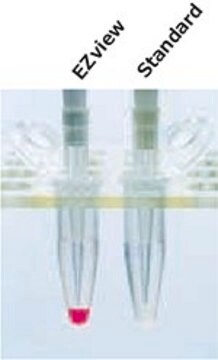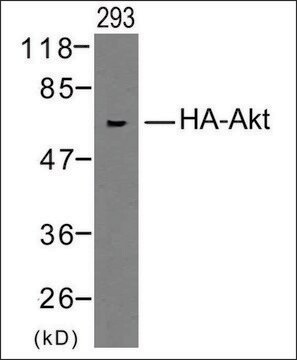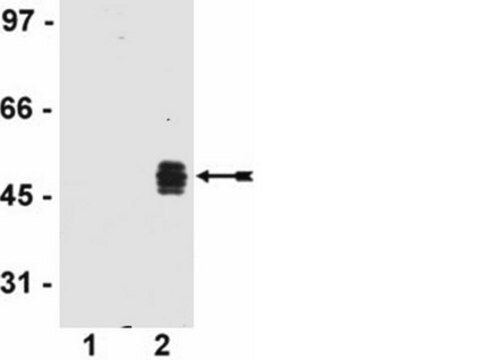추천 제품
생물학적 소스
rat
Quality Level
결합
biotin conjugate
항체 형태
purified immunoglobulin
항체 생산 유형
primary antibodies
클론
3F10, monoclonal
형태
lyophilized (stabilized)
포장
pkg of 50 μg
제조업체/상표
Roche
동형
IgG1
에피토프 서열
YPYDVPDYA
저장 온도
2-8°C
관련 카테고리
일반 설명
Anti-HA-Biotin, High Affinity (3F10) is a monoclonal antibody for the highly sensitive detection of HA-tagged recombinant proteins, Fab fragments, conjugated to biotin. The Anti-HA-Biotin, High Affinity antibody (clone 3F10) recognizes the same epitope as clone 12CA5. It is a monoclonal antibody whose high affinity and low working concentrations result in less cross-reactivity than with other antibodies to the HA-epitope. Anti-HA-Biotin, High Affinity (3F10) is a biotin conjugate of this clone which is specifically useful in western blotting, ELISA applications and assays using the universal biotin-streptavidin platform, by allowing specific and highly sensitive detection of HA-tagged proteins.
특이성
Anti-HA-Biotin, High Affinity (3F10) recognizes the 9-amino acid sequence YPYDVPDYA, derived from the human influenza hemagglutinin (HA) protein. This epitope is also recognized in fusion proteins regardless of its position (N-terminal, C-terminal or internal).
면역원
Amino acids 98-106 from the human influenza virus hemagglutinin protein
애플리케이션
Anti-HA-Biotin, High Affinity (3F10) is used for the detection of HA-tagged recombinant proteins using:
It has also been used for immunocytochemistry, immunofluorescence and αScreen format based assay.
- Dot blots
- ELISA (enzyme-linked immunosorbent assay)
- Western blots
It has also been used for immunocytochemistry, immunofluorescence and αScreen format based assay.
품질
Function test: The Anti-HA-Biotin; High Affinity is function tested by Western blot analysis of a HA-tagged fusion protein.
제조 메모
Sample Materials
Sample preparation: Prepare protein extracts containing the HA-tagged protein of interest using any of a variety of standard methods. The following lysis buffers have performed well and should be taken as guidelines:
Sample preparation: Prepare protein extracts containing the HA-tagged protein of interest using any of a variety of standard methods. The following lysis buffers have performed well and should be taken as guidelines:
- Bacterial extracts: 20 mM Tris, pH 8.0, 100 mM NaCl, cOmplete Protease Inhibitor Cocktail Tablets, followed by freeze-thaw.
- Mammalian extracts: 50 mM Tris, pH 7.5, 150 mM NaCl, 0.1% Nonidet P40, complete Protease Inhibitor Cocktail Tablets.
- Other cell lysis buffers may be more appropriate for individual applications. In general, to obtain optimal performance of the affinity matrix:
- Use protease inhibitors to reduce proteolytic activity. Use complete Protease Inhibitor Cocktail Tablets for most applications.
- Limit detergent to the lowest concentration levels necessary to obtain adequate cell lysis.
Working concentration: Working concentration of conjugate depends on application and substrate
The following concentrations should be taken as a guideline:
The following concentrations should be taken as a guideline:
- Dot blot: 100 ng/ml
- ELISA: 100 ng/ml
- Western blot: 100 ng/ml
재구성
Add 1 ml double-distilled water to a final concentration of 50 μg/ml.
Rehydrate for 10 minutes prior to use.
Rehydrate for 10 minutes prior to use.
기타 정보
For life science research only. Not for use in diagnostic procedures.
적합한 제품을 찾을 수 없으신가요?
당사의 제품 선택기 도구.을(를) 시도해 보세요.
신호어
Warning
유해 및 위험 성명서
Hazard Classifications
Aquatic Chronic 3 - Skin Sens. 1
Storage Class Code
11 - Combustible Solids
WGK
WGK 2
Flash Point (°F)
does not flash
Flash Point (°C)
does not flash
시험 성적서(COA)
제품의 로트/배치 번호를 입력하여 시험 성적서(COA)을 검색하십시오. 로트 및 배치 번호는 제품 라벨에 있는 ‘로트’ 또는 ‘배치’라는 용어 뒤에서 찾을 수 있습니다.
이미 열람한 고객
Edward J Hsieh et al.
Archives of biochemistry and biophysics, 463(1), 19-26 (2007-03-30)
Coenzyme Q (Q) is a redox active lipid that is an essential component of the electron transport chain. Here, we show that steady state levels of Coq3, Coq4, Coq6, Coq7 and Coq9 polypeptides in yeast mitochondria are dependent on the
Paul A Rowley et al.
PLoS pathogens, 12(10), e1005890-e1005890 (2016-10-07)
In eukaryotes, the degradation of cellular mRNAs is accomplished by Xrn1 and the cytoplasmic exosome. Because viral RNAs often lack canonical caps or poly-A tails, they can also be vulnerable to degradation by these host exonucleases. Yeast lack sophisticated mechanisms
Derek C Prosser et al.
Journal of cell science, 128(22), 4220-4234 (2015-10-16)
Clathrin-mediated endocytosis (CME) is a well-studied mechanism to internalize plasma membrane proteins; however, to endocytose such cargo, most eukaryotic cells also use alternative clathrin-independent endocytic (CIE) pathways, which are less well characterized. The budding yeast Saccharomyces cerevisiae, a widely used
Kenji Tamura et al.
Oncology letters, 14(6), 6650-6658 (2018-01-19)
The present study aimed at identifying novel molecular cancer drug targets and biomarkers by analyzing the gene expression profiles of high-grade prostate cancer (PC), using a cDNA microarray combined with laser microbeam microdissection. A number of genes were identified that
Daniel M Freed et al.
Cell, 171(3), 683-695 (2017-10-11)
Epidermal growth factor receptor (EGFR) regulates many crucial cellular programs, with seven different activating ligands shaping cell signaling in distinct ways. Using crystallography and other approaches, we show how the EGFR ligands epiregulin (EREG) and epigen (EPGN) stabilize different dimeric
자사의 과학자팀은 생명 과학, 재료 과학, 화학 합성, 크로마토그래피, 분석 및 기타 많은 영역을 포함한 모든 과학 분야에 경험이 있습니다..
고객지원팀으로 연락바랍니다.













